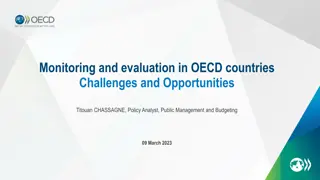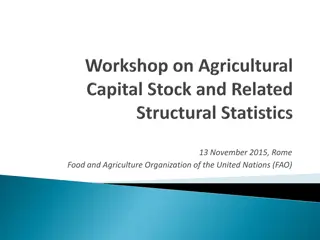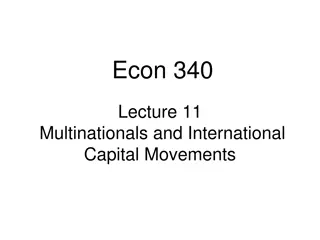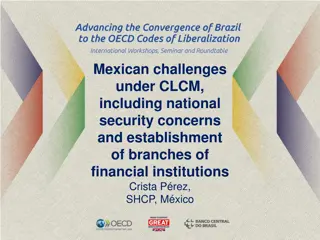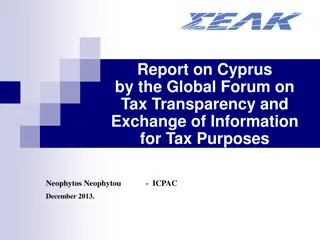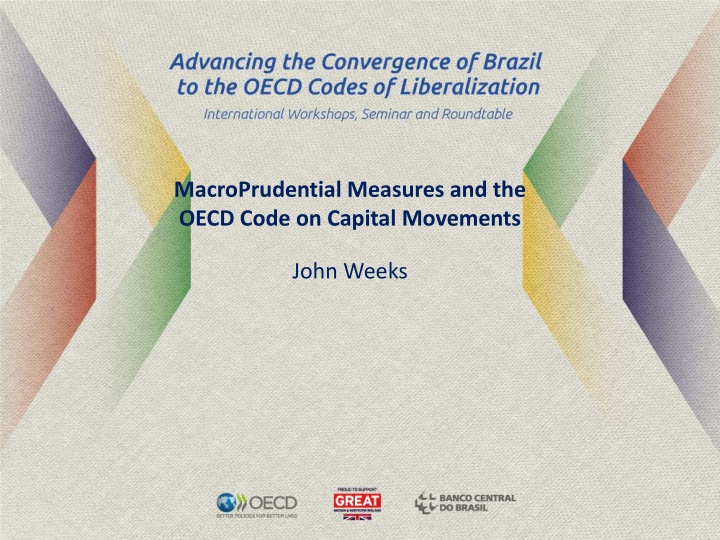
MacroPrudential Measures and the OECD Code on Capital Movements
This content provides insights into the role of macroprudential measures and the OECD Code on Capital Movements. It discusses the benefits, challenges, and areas of review surrounding the Code, regulators' need for effective toolkits, and the impact of macroprudential measures outside the Code.
Download Presentation

Please find below an Image/Link to download the presentation.
The content on the website is provided AS IS for your information and personal use only. It may not be sold, licensed, or shared on other websites without obtaining consent from the author. If you encounter any issues during the download, it is possible that the publisher has removed the file from their server.
You are allowed to download the files provided on this website for personal or commercial use, subject to the condition that they are used lawfully. All files are the property of their respective owners.
The content on the website is provided AS IS for your information and personal use only. It may not be sold, licensed, or shared on other websites without obtaining consent from the author.
E N D
Presentation Transcript
MacroPrudential Measures and the OECD Code on Capital Movements John Weeks
The Code Has Been (and Is) a Force for Good Code Represents a Set of Voluntary Rules by Participating Adherents Concerning Residents Access to Each Others Financial Services and Markets Prohibits Discrimination in Access to Financial Markets and Access to Foreign Currency Code is Flexible in Allowing Protective Measures if Needed The Code has Operated Smoothly Historically; Adherents have Enthusistically Embraced the Goal of Progressive Liberalization
Some Unsettled Areas Code is Under Review; Fresh Look Needed from Time to Time Key Catalyst fpr the Review is the Increased Use of MacroPrudential Measures in Aftermath of Financial Crisis Review of the Code has been Inclusive , Active Participation of Other IOs and Many Non Members Over the Past Two Years Consensus is Emerging that Only a Little Fine-Tuning is Needed
MacroPrudential Measures and the Code Regulators Need Effective Toolkits to Manage Systemic Risks to Domestic Financial Systems But Toolkits also Need to Have Well Thought Out Policy Frameworks and Operational Frameworks that Govern Their Use Some Countries Use MacroPrudential Measures to Control Capital Flows, or Use Capital Flow Measures and Call Them MacroPrudential Use of Capital Flow Measures with a MacroPrudential Intent Intersects with the IMF s Institutional View and the Code
Most MacroPrudential Measures Fall Outside the Code Majority of MacroPrudential Measures Have the Effect of Limiting Operations Between and Among Residents, and Thus do not Affect Capital Flows or the Ability to Conclude an International Transaction Examples are Ceilings on Loan-to-Value and/or Debt-to- Income Ratios and Credit Ceilings on Loans to Individual Firms or Industries For a Measure to Have a Bearing on the Code, it Must Affect an Operation that is Specifically Listed in One or More of the Operations Spelled out in the Code s List A and List B Operations
Access to Foreign Currencies A Key Aspect of the Code is That All Operations in the Code are Liberalized Regardless of the Currency in Which They are Denominated or Settled. There Should be No Financial Restrictions on Access to Currency Non-Residents from an Adhering Country Should Have the Same Access to the Same Facilities and Use of the Same Currencies that are Permitted Residents in the Resident Country And Residents Should be Permitted the Use of any Facility and Currency that May be Used by Non-Residents in Other Adhering Countries
Flexibility of the Code The Code is Extremely Flexible. For List B Operations, Adherents May Introduce, or Re- Introduce a Restriction at Any Time. Further Flexibility Exists Under Derogation Clauses in Situations of Extreme Stress (Greece, Iceland). List A Operations are Subject to a Standstill, but They Too May be Addressed in More Extreme Situations. A Number of MPMs are Carved Out of Code Obligations.
Examples of MacroPrudential Measures That are Also Capital Flows Measures Limits on FX Derivatives Setting a Ceiling, Reserve Requirement, or Other Requirement(s) on the Use by Domestic Banks of Foreign Exchange Derivative Contracts (including the use of swaps and forwards, etc.). Goal is to Boost Short-Term FX Funding Costs and thus Discourage Their Use. Has a Bearing on the Code Inasmuch as it Extends to Operations Carried out Abroad by Resident Banks (List B: Operations in Foreign Exchange). Adhering Country Should Take a Reservation, as it is Not Fulfilling the Obligation to Allow Complete Freedom of Access to Foreign Exchange.
Examples of MacroPrudential Measures That are Also Capital Flows Measures Higher Taxes on Non- Residents Purchases of Residential Property Used to Prevent Overheating of the Domestic Residential Property Market Due to Strong Foreign Buying. Goal is to Increase the Cost tp Foreign Buyers of Purchasing Domestic Residential Property; Discourage Their Demand and thus Dampen Upward Pressure on the Domestic Residential Property Market. Has a Bearing on the Code under List B: Operations in Real Estate.
Examples of MacroPrudential Measures That are Also Capital Flows Measures Taxing Banks Short-Term FX Liabilities Imposing a Tax on a Short-Term Instrument by a Domestic Bank Used to Raise Foreign Exchange. Increases the Cost of Short-Term Foreign Exchange Funding; Goal is to Discourage FX Liabilities of Domesitc Banks. Restricts the Freedom of Residents to Freely Decide on the Use of Currency for Denomination with non Residents. List B: Operations on Money Markets, Financial Credits, and Loans.
Examples of MacroPrudential Measures That are Also Capital Flows Measures Reserve Requirements on Banks Credit Lines with Non-Residents Similar to Other Restrictions on Access by Banks to Foreign Exchange Funding, the Goal is to Discourage the Amount of Foreign Exchange Exposure by Raising the Cost of Such Borrowings. Depending on the Maturity of the Credit Line, Could be a List A or a List B Restriction.
MacroPrudential Carve-Outs and Exemptions The Code Permits Regulators to Manage the Foreign Exchange Exposures of Residents. Ceilings May be Set on Net FX Exposures, or Capital Requirements. Adherents also Leaning in Direction of Carving Out Basel III Liquidity Ratios from Interference with Code Obligations. Thus Code-Consistent Ways Exist to Manage Risks from Foreign Capital Inflows and Concerns Over FX Exposures. If Insufficient, Reservations May be Taken for Short-Term, List B Obligations.
Conclusion Most Adherents have Concluded that the Code has Worked Very Well. The Overarching Goal is Progressive Liberalization, but each Adherent has Some Reservations (restrictions). There is Considerable Leeway in Addressing Most Concerns. 1. First, Most MacroPrudential Measures do not Intersect with Code Obligations. 2. Second, the Code has Code-Consistent Ways of Managing Risks Associated with FX Exposures. 3. Third, The Code Allows for the Re-Imposition of Restrictions if Needed. 4. Fourth, the Code has Provisions in the Event of Extreme Financial Stress. Adherents are Supportive of the IMF s IV Approach that the First Response Should be Macroeconomic in the Event of Capital Flow Disturbances.


